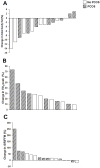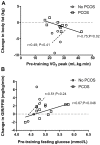Exploring factors related to changes in body composition, insulin sensitivity and aerobic capacity in response to a 12-week exercise intervention in overweight and obese women with and without polycystic ovary syndrome
- PMID: 28771628
- PMCID: PMC5542389
- DOI: 10.1371/journal.pone.0182412
Exploring factors related to changes in body composition, insulin sensitivity and aerobic capacity in response to a 12-week exercise intervention in overweight and obese women with and without polycystic ovary syndrome
Abstract
Objective: To determine factors associated with differential changes in body fat, insulin resistance and aerobic capacity following a 12-week exercise intervention in overweight and obese women with and without polycystic ovary syndrome (PCOS).
Methods: 16 overweight and obese women (9 PCOS; 7 without PCOS) completed a supervised progressive 12-week exercise program. Primary outcomes included changes in indicators of insulin sensitivity (including glucose infusion rate relative to fat-free mass [GIR/FFM]), body composition, and aerobic capacity (VO2 peak; 12 participants only). Comparisons were made between women with and without PCOS, and between participants who lost ≥5% (classified as exercise responders) and <5% (non-responders) in body fat (assessed by dual-energy X-ray absorptiometry).
Results: Training decreased body fat percentage by (mean; 95% CI) -2.3%; -5.3, 0.7% in women with PCOS and by -6.4%; -10.9, -1.9% in women without PCOS (P = 0.08). Ten women (7 PCOS; 3 without PCOS) did not reduce body fat by ≥5%. All participants improved VO2 peak (mean change 27%; 16-39%) but four (2 PCOS; 2 without PCOS) demonstrated decreases in GIR/FFM (mean change for whole cohort: 37%; 3-71%). Android-gynoid fat ratio (0.58; 0.51, 0.66 vs 0.46; 0.40, 0.51; P<0.01) was significantly higher and GIR/FFM (6.69; 3.49, 9.90 vs 11.44; 9.15, 13.72 mg/kg/min; P = 0.01) was significantly lower in non-responders compared with responders at baseline, but non-responders had significant post-training decreases in android-gynoid ratio (-0.02; -0.04, -0.01; P = 0.03), and increases in VO2 peak (7.24; 2.28, 12.21 mL/kg/min; P = 0.01) and GIR/FFM (1.44; 0.27, 2.61 mg/kg/min; P = 0.02). In women with PCOS, pre-training VO2 peak was significantly negatively correlated with change in total body fat (r = -0.75; P = 0.02), and pre-training fasting glucose negatively correlated with changes in VO2 peak (r = -0.76; P = 0.04), but positively correlated with changes in GIR (r = 0.67; P = 0.046).
Conclusion: A high proportion of overweight and obese women with PCOS had small reductions in body fat following a 12-week exercise intervention, but nevertheless significantly reduced relative central adiposity and improved aerobic capacity and insulin sensitivity.
Conflict of interest statement
Figures



References
-
- Teede HJ, Misso ML, Deeks AA, Moran LJ, Stuckey B, Wong J, et al. Assessment and management of polycystic ovary syndrome: summary of an evidence-based guideline. Med J Aust. 2011;195(6):S65 - PubMed
-
- Moran LJ, Hutchison SK, Norman RJ, Teede HJ. Lifestyle changes in women with polycystic ovary syndrome. Cochrane Database Syst Rev. 2011;(2). doi: 10.1002/14651858.CD007506.pub2 - DOI - PubMed
-
- Harrison CL, Lombard CB, Moran LJ, Teede HJ. Exercise therapy in polycystic ovary syndrome: a systematic review. Hum Reprod Update. 2011;17(2):171–83. doi: 10.1093/humupd/dmq045 - DOI - PubMed
-
- Harrison CL, Stepto NK, Hutchison SK, Teede HJ. The impact of intensified exercise training on insulin resistance and fitness in overweight and obese women with and without polycystic ovary syndrome. Clin Endocrinol (Oxf). 2012;76(3):351–7. - PubMed
-
- Jaatinen TA, Anttila L, Erkkola R, Koskinen P, Laippala P, Ruutiainen K, et al. Hormonal responses to physical exercise in patients with polycystic ovarian syndrome. Fertil Steril. 1993;60(2):262–7. . - PubMed
MeSH terms
LinkOut - more resources
Full Text Sources
Other Literature Sources
Medical

